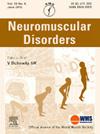213P Sensitivity to change of the motor function measure (MFM) in myotonic dystrophy type 1
IF 2.8
4区 医学
Q2 CLINICAL NEUROLOGY
引用次数: 0
Abstract
Myotonic dystrophy type 1 (DM1) is a hereditary multisystemic disease characterized by progressive muscle wasting, heart conduction abnormalities, early-onset cataract, and endocrinological disorders. It is caused by a non-coding CTG repeat expansion in the DMPK gene. With new therapeutic advancements and ongoing clinical trials focusing on siRNA, antisense oligonucleotides or gene therapy, there is an imperative to identify a suitable clinical outcome to assess motor function in DM1. The Motor Function Measure is a 3-dimensional quantitative scale (D1: standing/transfers, D2: Proximal/axial, D3: Distal) designed to monitor motor function in patients with neuromuscular diseases encompassing the spectrum of the disease regardless disease severity or functional level. This is a multicentric retrospective review of adults and children with a genetic diagnosis of DM1. Included subject were male or female DM1 patients with the availability of at least 2 MFM32 scores at 1 year. MFM32’s mean slope of change and standard response mean (SRM) were calculated. 343 subjects were included. At the first MFM mean age was 36.3 years (+/- 16.1, min: 6.1yo; max: 71.8yo), and mean MFM32 scores were 69.1%+/-25.1, 91.9%+/-9.1, 90.8.1%+/-8.4, and 82.4%+/-13.8 for D1, D2, D3 and Total score respectively. Average time between first and last assessments was 5.1 years (+/- 3.6, min: 1 y; max: 15.9yo). MFM32’s yearly mean slope of change was -2.25% (+/-3.86) for D1, -1.09% (+/-3.50) for D2, -0.54% (+/-2.95) for D3, -1.44 (+/-2.46) for total score. SRM was -0.58 for D1, -0.31 for D2, -0.18 for D3, -0.59 for total score. Understanding the change over time in a natural history cohort is important to understand the impact of change against a changing disease landscape. We showed MFM32’s responsiveness to change most relevant in the standing and transfer domain (D1) and MFM total score than the more proximal or distal domains.
213P 1 型肌张力营养不良症运动功能测量(MFM)对变化的敏感性
肌营养不良症 1 型(DM1)是一种遗传性多系统疾病,以进行性肌肉萎缩、心脏传导异常、早发白内障和内分泌失调为特征。它是由 DMPK 基因中的非编码 CTG 重复扩增引起的。随着新疗法的发展,以及正在进行的以 siRNA、反义寡核苷酸或基因疗法为重点的临床试验,确定一种合适的临床结果来评估 DM1 的运动功能势在必行。运动功能量表是一种三维定量量表(D1:站立/移位,D2:近端/轴向,D3:远端),旨在监测神经肌肉疾病患者的运动功能,涵盖疾病的各个阶段,无论疾病严重程度或功能水平如何。这是一项多中心回顾性研究,研究对象为经基因诊断为 DM1 的成人和儿童。研究对象为男性或女性 DM1 患者,且在 1 年内至少有 2 次 MFM32 评分。计算MFM32的平均变化斜率和标准反应平均值(SRM)。共纳入 343 名受试者。首次 MFM 平均年龄为 36.3 岁(+/- 16.1,最小:6.1 岁;最大:71.8 岁),D1、D2、D3 和总分的 MFM32 平均得分分别为 69.1%+/-25.1、91.9%+/-9.1、90.8.1%+/-8.4 和 82.4%+/-13.8。首次评估与最后一次评估之间的平均间隔时间为 5.1 年(+/- 3.6,最小:1 年;最大:15.9 年)。MFM32 的年平均变化斜率为:D1-2.25%(+/-3.86),D2-1.09%(+/-3.50),D3-0.54%(+/-2.95),总分-1.44(+/-2.46)。D1 的 SRM 为-0.58,D2 为-0.31,D3 为-0.18,总分为-0.59。了解自然史队列随时间的变化对于了解变化对不断变化的疾病状况的影响非常重要。我们发现,MFM32 对站立和转移领域(D1)和 MFM 总分变化的反应能力最强,而对近端或远端领域的反应能力较弱。
本文章由计算机程序翻译,如有差异,请以英文原文为准。
求助全文
约1分钟内获得全文
求助全文
来源期刊

Neuromuscular Disorders
医学-临床神经学
CiteScore
4.60
自引率
3.60%
发文量
543
审稿时长
53 days
期刊介绍:
This international, multidisciplinary journal covers all aspects of neuromuscular disorders in childhood and adult life (including the muscular dystrophies, spinal muscular atrophies, hereditary neuropathies, congenital myopathies, myasthenias, myotonic syndromes, metabolic myopathies and inflammatory myopathies).
The Editors welcome original articles from all areas of the field:
• Clinical aspects, such as new clinical entities, case studies of interest, treatment, management and rehabilitation (including biomechanics, orthotic design and surgery).
• Basic scientific studies of relevance to the clinical syndromes, including advances in the fields of molecular biology and genetics.
• Studies of animal models relevant to the human diseases.
The journal is aimed at a wide range of clinicians, pathologists, associated paramedical professionals and clinical and basic scientists with an interest in the study of neuromuscular disorders.
 求助内容:
求助内容: 应助结果提醒方式:
应助结果提醒方式:


